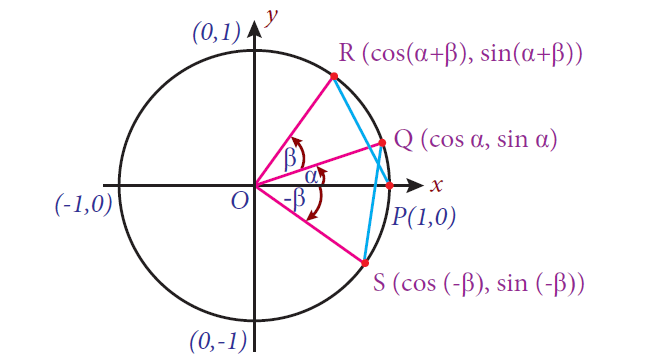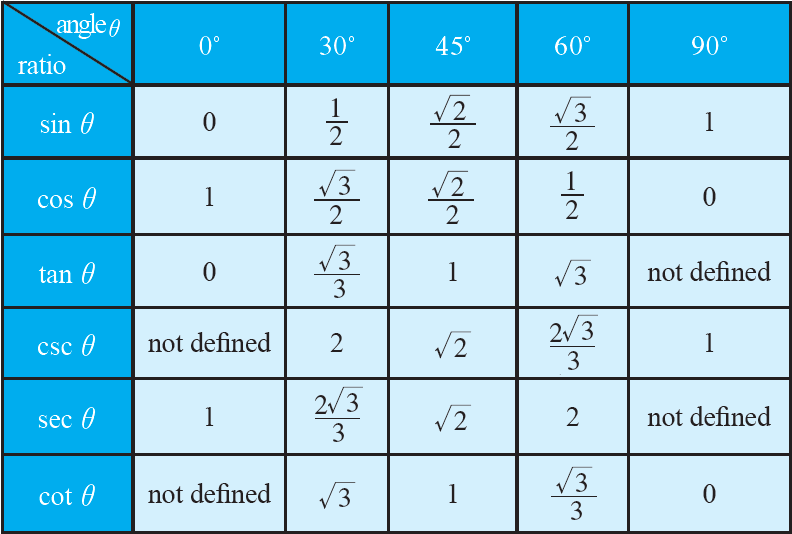COMPOUND ANGLES FORMULAS
Subscribe to our ▶️ YouTube channel 🔴 for the latest videos, updates, and tips.
Now, compound angles are algebraic sum of two or more angles. Trigonometric functions do not satisfy the functional relations like
f(x + y) = f(x) + f(y) and f(kx) = kf(x), k is a real number
For example,
cos(α + β) ≠ cosα + cosβ, sin2α ≠ 2sinα, tan3β ≠ 3tanβ
Thus we need to derive formulas for
sin(α + β), cos(α + β), tan(α + β)
and use them in calculations of application problems.
Formula 1 : cos(α + β) = cosαcosβ - sinαsinβ
Proof :
Consider the unit circle with center at O. Let P = P(1, 0).
Let Q, R and S be points on the unit circle such that
∠POQ = α, ∠POR = α + β and ∠POS = -β
as shown in the figure shown below.

Clearly angles α, α + β and -β are in standard positions. Now, the points Q, R and S are given by
Q(cosα, sinα)
R(cos(α + β), sin(α + β))
S(cos(-β), sin(-β))
ΔPOR and ΔSOQ are congruent.
So, PR = SQ which gives PR2 = SQ2.
Thus, [cos(α + β) - 1]2 + sin2(α + β) :
= [cosα - cos(-β)]2 + [sinα - sin(-β)]2 - 2cos(α + β) + 2
= 2 - 2cosαcosβ + 2sinαsinβ
Hence,
cos(α + β) = cosαcosβ - sinαsinβ
Note :
(i) In the above proof, PR = SQ says that the distance between two points on a circle is determined by the radius and the central angle.
(ii) Arcs PR and SQ subtend angles α + β and α + (-β) respectively at the center. Thus PR = SQ. Thus, distance between the points (cosα, sinα) and (cos(-β), sin(-β)) is same as the distance between the points
(cos(α + β), sin(α + β)) and (1, 0)
(iii), In the above derivations, 0 ≤ α ≤ 2π, 0 ≤ β ≤ 2π. Because of periodicity of sine and cosine, the result follows for any α and β.
Formula 2 : cos(α - β) = cosαcosβ + sinαsinβ
Proof :
We know that cos(α + β) = cosα cosβ - sinα sinβ
Now,
cos(α - β) = cos[α + (-β)]
= cosαcos(-β) - sinαsin(-β)
Hence,
cos(α - β) = cosαcosβ + sinαsinβ
Note :
(i) If α = β, the above formula is reduced to
cos2α + sin2α = 1
(i) If α = 0 and β = x, then cos(-x) = cosx, which shows that cosx is an even function.
Formula 3 : sin(α + β) = sinαcosβ + cosαsinβ
Proof :
This formula may be proved by writing
sin(α + β) = cos[π/2 - (α + β)]
= cos[(π/2 - α) - β]
Using Formula 2,
= cos(π/2 - α)cosβ + sin(π/2 - α)sinβ
Hence,
sin(α + β) = sinαcosβ + cosαsinβ
Note :
If α + β = π/2, the above identity is reduced to
cos2α + sin2α = 1
Formula 4 : sin(α - β) = sinαcosβ - cosαsinβ
Proof :
This formula may be proved by writing
sin(α - β) = sin[α + (-β)]
Using Formula 3,
= sinαcos(-β) + cosαsin(-β)
Hence,
sin(α - β) = sinαcosβ - cosαsinβ
Formula 5 : tan(α + β) = (tanα + tanβ)/(1 - tanαtanβ)
Proof :
tan(α + β) = sin(α + β)/cos(α + β)
= (sinαcosβ + cosαsinβ)/(cosαcosβ - sinαsinβ)
Dividing both numerator and denominator by cosαcosβ,
tan(α + β) = (tanα + tanβ)/(1 - tanαtanβ)
Formula 6 : tan(α - β) = (tanα - tanβ)/(1 + tanαtanβ)
Proof :
tan(α + β) = tan[(α + (-β)]
Using Formula 5,
= [tanα + tan(-β)]/[(1 - tanαtan(-β)]
tan(α + β) = (tanα - tanβ)/(1 + tanαtanβ)
Trigonometric Ratio Table

From the above table, we can get the values of trigonometric ratios for standard angles such as 0°, 30°, 45°, 60°, 90°.
Solved Problems
Problem 1 :
Find the value of cos15°.
Solution :
Write the given angle 15° in terms of sum or difference of two standard angles.
15° = 45° - 30°
cos15° = cos(45° - 30°)
= cos45°cos30° + sin45°sin30°
Using the above trigonometric ratio table, we have
= (√2/2) ⋅ (√3/2) + (√2/2) ⋅ (1/2)
= (√6/4) + (√2/4)
= (√6 + √2)/4
Problem 2 :
Find the value of sin75°.
Solution :
Write the given angle 75° in terms of sum or difference of two standard angles.
75° = 45° + 30°
sin75° = sin(45° + 30°)
sin75° = sin45°cos30° + cos45°sin30°
Using the above trigonometric ratio table, we have
= (√2/2) ⋅ (√3/2) + (√2/2) ⋅ (1/2)
= (√6/4) + (√2/4)
= (√6 + √2)/4
Problem 3 :
Find the value of tan15°.
Solution :
Write the given angle 15° in terms of sum or difference of two standard angles.
15° = 45° - 30°
tan15° = tan(45° - 30°)
tan15° = (tan45° - tan30°)/(1 + tan45°tan30°)
Using the above trigonometric ratio table, we have
= (1 - 1/√3)/(1 + 1 ⋅ 1/√3)
= (1 - 1/√3)/(1 + 1/√3)
= (√3/√3 - 1/√3)/(√3/√3 + 1/√3)
= [(√3 - 1)/√3]/[(√3 + 1)/√3]
= [(√3 - 1)/√3] x [(√3/(√3 + 1)]
= (√3 - 1)/(√3 + 1)
By rationalizing the denominator, we get
= 2 - √3
Problem 4 :
Find the value of tan165°.
Solution :
Write the given angle 165° in terms of sum or difference of two standard angles.
165° = 120° + 45°
tan165° = tan(120° + 45°)
tan165° = (tan120° + tan45°)/(1 - tan120°tan45°) ----(1)
tan120° = tan(180° - 60°) = -tan60° = -√3.
(1)----> = (-√3 + 1)/[1 - (-√3)(1)]
= (1 - √3)/(1 + √3)
Problem 5 :
If sinA = 4/5 (in quadrant I) and cosB = -12/13 (in quadrant II), then find (i) sin(A - B), (i) cos(A- B).
Solution :
sin2A + cos2A = 1
cos2A = 1 - sin2A
cosA = ±√(1 - sin2A)
Substitute sinA = 4/5.
cosA = ±√[1 - (4/5)2]
= ±√[1 - 16/25]
= ±√[(25 - 16)/25]
= ±√(9/25)
= ± 3/5
In the first quadrant, cosA is always positive.
cosA = 3/5
And also,
sin2B + cos2B = 1
sin2B = 1 - cos2B
sinB = ±√(1 - cos2B)
Substitute cosB = -12/13.
sinB = ±√[1 - (-12/13)2]
= ±√[1 - 144/169]
= ±√[(169 - 144)/169]
= ±√[25/169]
= ± 5/13
In the second quadrant sinB is always positive.
sinB = 5/13
sin(A - B) :
= sinAcosB - cosAsinB
= (4/5)(-12/13) - (3/5)(5/13)
= -48/65 - 15/65
sin(A- B) = -63/65
cos(A - B) :
= cosAcosB + sinAsinB
= (3/5)(-12/13) + (4/5)(5/13)
= -36/65 + 20/65
cos(A- B) = -16/65
Problem 6 :
If sinA = 3/5 and cosB = 9/41 , 0 < A < π/2, 0 < B < π/2, find the value of (i) sin(A + B) (ii) cos(A − B).
Solution :
|
sinA = 3/5 cosA = √(1 - sin2x) = √(1 - (3/5)2) = √(1 - (9/25)) = √(25 - 9)/25 = √(16/25) cosA = 4/5 |
cosB = 9/41 sinB = √(1 - cos2B) = √(1 - (9/41)2) = √(1 - (81/1681) = √(1681 - 81)/1681 = √(1600/1681) sinB = 40/41 |
sin(A + B) :
= sinAcosB + cosAsinB
= (3/5)(9/41) + (4/15)(40/41)
= (27/205) + (160/205)
= (27 + 160)/205
= 187/205
cos(A - B) :
= cosAcosB + sinAsinB
= (4/5)(9/41) + (3/5)(40/41)
= (36/205) + (120/205)
= (36 + 120)/205
= 156/205
Subscribe to our ▶️ YouTube channel 🔴 for the latest videos, updates, and tips.
Kindly mail your feedback to v4formath@gmail.com
We always appreciate your feedback.
About Us | Contact Us | Privacy Policy
©All rights reserved. onlinemath4all.com

Recent Articles
-
10 Hard SAT Math Questions (Part - 40)
Dec 25, 25 08:30 AM
10 Hard SAT Math Questions (Part - 40) -
10 Hard SAT Math Questions (Part - 41)
Dec 24, 25 07:58 PM
10 Hard SAT Math Questions (Part - 41) -
ASTC Formula in Trigonometry
Dec 23, 25 11:34 PM
ASTC Formula in Trigonometry - Concepts - Examples and Solved Problems


